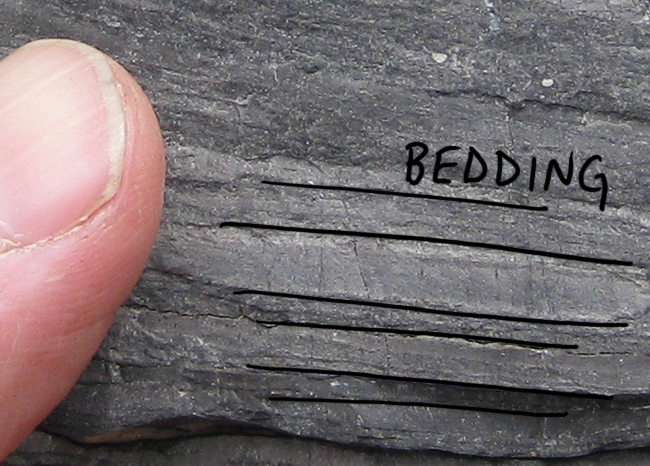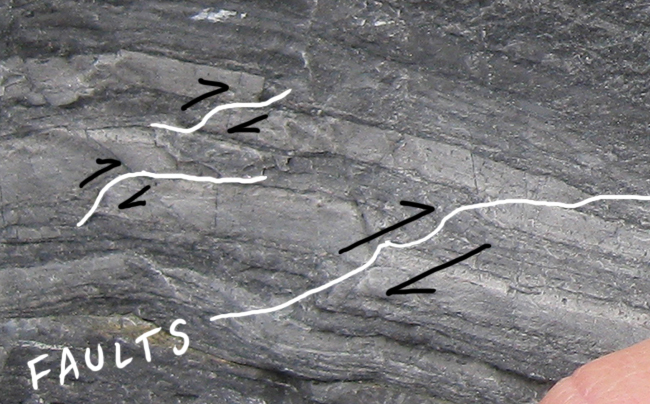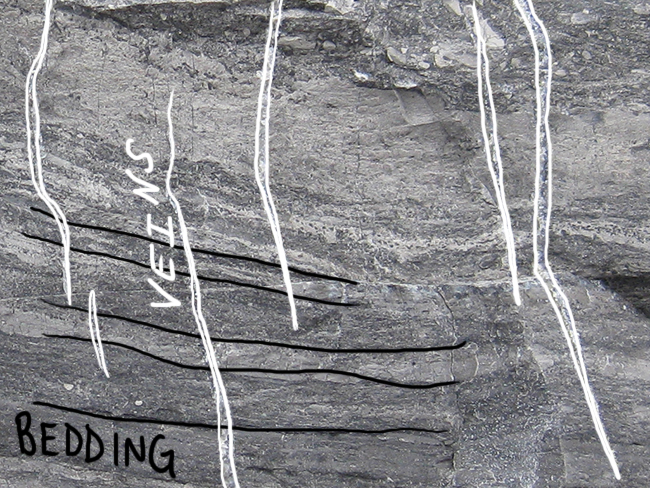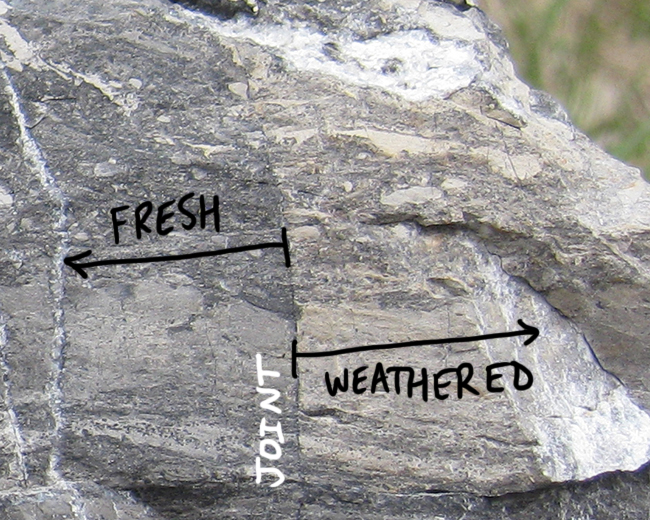5 June 2014
Palimpsest tales from a Silurian limestone
Posted by Callan Bentley
My favorite rocks are those that tell multiple stories – rocks that are “palimpsest” with subsequent “chapters” of their biography capable of being teased out, based on different features to be observed in the rock.
What can we see in this small sample of the Silurian-aged Tonoloway limestone, from Corridor H, West Virginia?
To start with, it’s sedimentary, and stratified. There are multiple layers of fine-grained gray limestone:

Limestone today is deposited in warm waters of tropical seas, like off the coast of Florida or the Bahamas.
The fine grain size suggests very calm, tranquil conditions of accumulation. Up toward the top of the sample, however, we see a change in the story – the water energy must have increased temporarily, because we see chunks of this fine-grained limestone “suspended” in a coarser-grained matrix. These “rip-up” clasts suggest a storm or similar high-energy event is “Chapter 2” in the story of this sample.

And then there is a deformational story which overprints the depositional tale. For instance, the left side of the sample has some lovely small scale faults:

You can’t break a rock until it’s rock, so these structures suggest the sediment was no cohesively stuck together (lithified) into a rock by the time of their formation.
And then there are the joints, the more or less vertical fractures that cross-cut the bedding. Some of these brittle features show evidence of extension, as they are filled in with calcite to make white veins.

One of the joints on the right side of the sample seems to have served as a conduit for weathering of the rock. It provides a crisp boundary between weathered and fresh rock:

So the overall story this rock tells is: (1) limey mud was being deposited in calm conditions, probably in a shallow tropical sea, when suddenly (2) a storm (perhaps a hurricane?) hit, ripping up some of the earlier-deposited sediment and rolling the chunks around before dumping them anew, along with coarser chunks of lime from somewhere else, and then (3) it was lithified into limestone, whereupon (4) it was capable of being faulted, and having some of the layers climb on top of their neighbors under a regime of tectonic compression, and then (5) it broke and had fluids flow through those fractures, making (6) veins and then also facilitating (7) modern weathering.
Quite the saga imprinted on this little sample of rock! It’s amazing to consider how many stories are carried in the rocks that surround us every day.



 Callan Bentley is Associate Professor of Geology at Piedmont Virginia Community College in Charlottesville, Virginia. He is a Fellow of the Geological Society of America. For his work on this blog, the National Association of Geoscience Teachers recognized him with the James Shea Award. He has also won the Outstanding Faculty Award from the State Council on Higher Education in Virginia, and the Biggs Award for Excellence in Geoscience Teaching from the Geoscience Education Division of the Geological Society of America. In previous years, Callan served as a contributing editor at EARTH magazine, President of the Geological Society of Washington and President the Geo2YC division of NAGT.
Callan Bentley is Associate Professor of Geology at Piedmont Virginia Community College in Charlottesville, Virginia. He is a Fellow of the Geological Society of America. For his work on this blog, the National Association of Geoscience Teachers recognized him with the James Shea Award. He has also won the Outstanding Faculty Award from the State Council on Higher Education in Virginia, and the Biggs Award for Excellence in Geoscience Teaching from the Geoscience Education Division of the Geological Society of America. In previous years, Callan served as a contributing editor at EARTH magazine, President of the Geological Society of Washington and President the Geo2YC division of NAGT.